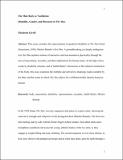Files in this item
The male body as vacillation : disability, gender, and discourse in The Men
Item metadata
| dc.contributor.author | Girelli, Elisabetta | |
| dc.date.accessioned | 2021-02-08T00:37:32Z | |
| dc.date.available | 2021-02-08T00:37:32Z | |
| dc.date.issued | 2019 | |
| dc.identifier | 252945741 | |
| dc.identifier | 4e0f2509-e885-4c67-b5cf-e1389d9fb021 | |
| dc.identifier.citation | Girelli , E 2019 , ' The male body as vacillation : disability, gender, and discourse in The Men ' , Screen Bodies , vol. 3 , no. 1 , pp. 87-97 . https://doi.org/10.3167/screen.2018.030106 | en |
| dc.identifier.issn | 2374-7552 | |
| dc.identifier.uri | https://hdl.handle.net/10023/21385 | |
| dc.description.abstract | This article considers the representation of gendered disability in The Men (Fred Zinnemann, 1950), Marlon Brando’s first film. A groundbreaking yet deeply ambiguous text, the film explores notions of normative and non-normative physicality through the lens of masculinity, sexuality, and their implications for human status. In the light of key works by disability scholars, and of Judith Butler’s discussion of the cultural construction of the body, this article examines the multiple and subversive meanings made available by the film, and the extent to which The Men allows for a different bodily identity based on dissent. | |
| dc.format.extent | 17 | |
| dc.format.extent | 650710 | |
| dc.language.iso | eng | |
| dc.relation.ispartof | Screen Bodies | en |
| dc.subject | Body | en |
| dc.subject | Disability | en |
| dc.subject | Judith Butler | en |
| dc.subject | Marlon Brando | en |
| dc.subject | Masculinity | en |
| dc.subject | Representations | en |
| dc.subject | Sexuality | en |
| dc.subject | PN1993 Motion Pictures | en |
| dc.subject | T-NDAS | en |
| dc.subject | BDC | en |
| dc.subject | R2C | en |
| dc.subject.lcc | PN1993 | en |
| dc.title | The male body as vacillation : disability, gender, and discourse in The Men | en |
| dc.type | Journal article | en |
| dc.contributor.institution | University of St Andrews. Film Studies | en |
| dc.identifier.doi | https://doi.org/10.3167/screen.2018.030106 | |
| dc.description.status | Peer reviewed | en |
| dc.date.embargoedUntil | 2021-02-08 |
This item appears in the following Collection(s)
Items in the St Andrews Research Repository are protected by copyright, with all rights reserved, unless otherwise indicated.

